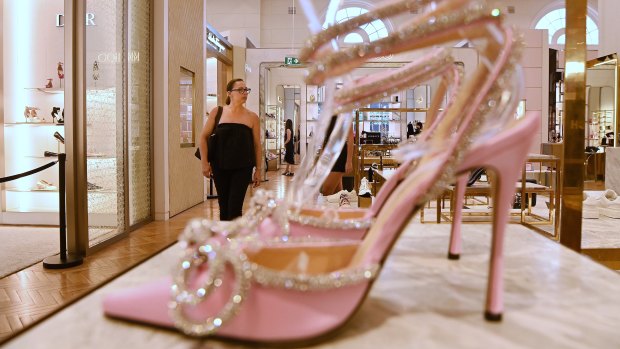Consumers’ doom and gloom in the cost-of-living crunch doesn’t seem to have dimmed the hopes of the nation’s big shopping centre landlords that they’re on the cusp of a retail recovery.
Australia’s shopping centre owners are reporting resilient occupancy levels and improving releasing spreads - an industry term for the difference between what a landlord got for an expiring lease and what they then charge on a new lease for the same space.

ABS figures showing retail spending in September was slower than expected, rising just 0.1 per cent during the month.Credit: Kate Geraghty
The boss of Scentre Group, which owns and runs the Westfield shopping centres, said on Thursday customer visits were up 2.1 per cent in the September quarter, sales have grown 2.3 per cent and occupancy in its malls has risen 30 basis points to 99.4 per cent.
The shopping centre giant’s leasing spreads lifted 1.7 per cent and average specialty rent escalations were up 5.5 per cent, chief executive Elliott Rusanow said. “Demand for space from a diverse range of business partners is strong,” he said.
His upbeat tone was echoed by analysts at investment house Citi.
“We come out of the recent trading updates still convinced that a consumer recovery is underway,” analyst Adrian Lemme said this week.
That’s despite ABS figures showing retail spending in September was softer than expected, rising just 0.1 per cent during the month. While consumers purchased more household goods, liquor sales fell sharply.
Lemme said retail trade was likely slower in October as well because consumers are waiting for the Black Friday sales at the end of this month. “We still expect a pick-up in November for the most promotional categories ... as consumers look for value.”
“Our analysis shows an ever-increasing proportion of sales are being done in November, suggesting sales growth could pick up by 3 to 4 percentage points in November. We still forecast a $55 billion lift in spending capacity [this financial year],” he said.
That’s welcome news for retail landlords who, over the past year, have seen sales stagnate as Australian households battle stubbornly high inflation, a housing crisis and other cost-of-living pressures. Since May 2022, interest rates have gone up 13 times.
Vicinity Centres, another shopping centre giant that owns Chatswood Chase and the Queen Victoria Building in Sydney along with the Emporium and Chadstone mega-mall in Melbourne, told investors late last month its CBD centres and Direct Factory Outlets (DFO) are outperforming.
City centres are returning to their “former vibrancy,” chief executive Peter Huddle said.
“Weekend visitation to our CBD assets now exceeds pre-pandemic levels and occupancy across the CBD assets leads the portfolio, at 99.4 per cent. Leasing spreads in the quarter were positive, driven by continued demand for stores in our premium assets,” he said.
Another large retail landlord, GPT, is also reflecting the trend. Sales in its centres grew a healthy 4.9 per cent, with specialty sales rising 5.3 per cent during the September quarter.
High-frequency consumer data published this week by investment giant Macquarie shows groceries are taking a larger share from consumers’ wallets, a theme supported by recent reports from Coles and Woolies.
Pharmacy spending is elevated as chemists eat into supermarket sales, and electronics is proving a resilient category despite headwinds to discretionary spending.
Spending on home improvement has taken a hit, furniture and hardware have fallen off and restaurants continue to lose share as households stop eating out.
Like Citi, Macquarie believes consumers are delaying purchases ahead of the Black Friday/Cyber Monday weekend at the end of November.
In the near-term, interest rates are expected to ease in early 2025, which – together with a resilient employment market – should provide a meaningful impetus to the resumption in consumer spending, Vicinity chairman Trevor Gerber said.
“The fundamentals of the Australian retail property sector continue to be favourable, supported by population growth, strong employment, the increasingly symbiotic relationship between physical retail stores and online, and with limited investment in new retail supply,” he said.
The Market Recap newsletter is a wrap of the day’s trading. Get it each weekday afternoon.